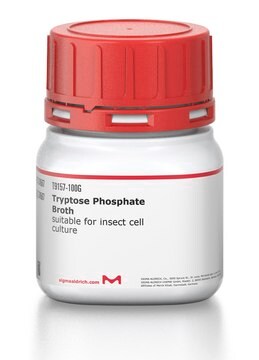G5154
Glasgow Minimum Essential Medium
With sodium bicarbonate, without ʟ-glutamine, liquid, sterile-filtered, suitable for cell culture
Synonym(e):
GMEM
About This Item
Empfohlene Produkte
Produktbezeichnung
Glasgow Minimum Essential Medium, With sodium bicarbonate, without L-glutamine, liquid, sterile-filtered, suitable for cell culture
Qualitätsniveau
Sterilität
sterile-filtered
Form
liquid
Methode(n)
cell culture | mammalian: suitable
Verunreinigungen
endotoxin, tested
Komponenten
L-glutamine: no
phenol red: 0.0213 g/L
NaHCO3: 2.75 g/L
glucose: 4.5 g/L (Dextro)
Versandbedingung
ambient
Lagertemp.
2-8°C
Suchen Sie nach ähnlichen Produkten? Aufrufen Leitfaden zum Produktvergleich
Allgemeine Beschreibung
Anwendung
- Hoxb7- green fluorescence protein (GFP) mouse embryonic stem (ES) cell line for the induction of ureteric bud differentiation
- murine E14 Tg2a embryonic stem (mES) cells
- transduced Chinese hamster ovary (CHO) cells for the expression and production of Siglec-1-Fc fusion proteins
Rekonstituierung
Ergänzung
auch häufig zusammen mit diesem Produkt gekauft
Lagerklassenschlüssel
12 - Non Combustible Liquids
WGK
WGK 1
Flammpunkt (°F)
Not applicable
Flammpunkt (°C)
Not applicable
Hier finden Sie alle aktuellen Versionen:
Besitzen Sie dieses Produkt bereits?
In der Dokumentenbibliothek finden Sie die Dokumentation zu den Produkten, die Sie kürzlich erworben haben.
Kunden haben sich ebenfalls angesehen
Unser Team von Wissenschaftlern verfügt über Erfahrung in allen Forschungsbereichen einschließlich Life Science, Materialwissenschaften, chemischer Synthese, Chromatographie, Analytik und vielen mehr..
Setzen Sie sich mit dem technischen Dienst in Verbindung.









